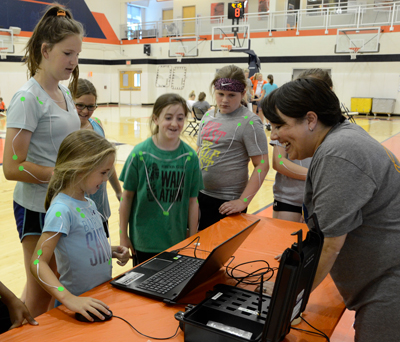Kersh studies what influences the mechanical and structural properties of bone
Baseball players. Postmenopausal women. NBA stars. Even sheep and horses. They all have something in common. They have smart bones.

Most living things do, said Mariana Kersh, an assistant professor of mechanical science and engineering who has studied athletes, animals, aging women, and many other groups as part of her research on the mechanical and structural properties of bone, cartilage, and connective tissue.
“Bone is very smart. It is constantly optimizing and adapting,” said Kersh, a member of the Beckman Institute’s Bioimaging Science and Technology Group. “Bone is always turning over. In fact, over our lifetimes, our bones are replaced several times.”
The how and why of bone adaptation and the role of muscle forces on bone is the focus of Kersh’s work. She uses computational models to make these determinations, and she uses the Visualization Laboratory (Vis Lab) at Beckman to help her do it.
“First, we use previously developed musculoskeletal models, which tell you what your muscle forces are during a given activity,” Kersh said. “And then we combine them with finite element models, which are what we develop at Beckman using CT data and the Molecular Imaging Lab. It’s a lot of data, and we need to have a way to process it efficiently.”
Why Beckman?
“Working with fellow Beckman members, faculty and staff, who are open to—and encouraging of—pushing forward new applications for the technologies and imaging capacities available at Beckman has been the most impactful part of being at the institute.”
—Mariana Kersh, assistant professor of mechanical science and engineering
That’s where the Vis Lab comes in. “This is a great resource for us in our research,” she explained. “The Vis Lab has the FiniteElement software that we need for the mechanical predictions as well as software for the initial imaging processing. The availability of these resources and the support of the Vis Lab staff enhances the efficiency of our work.”
In addition, it helps Kersh and her team gain valuable insights. “We can now begin to answer questions that up until now we could not,” Kersh said. “For instance, What is the nature of bone growth? What is the nature of bone adaptation? How does this manifest itself in different populations who are prone to fractures, such as basketball players who are more prone to tibial stress fractures? What does healthy bone porosity look like as we examine osteoporosis in women? How does exercise influence bone properties?”
Fighting Fractures
Kersh is interested in pursuing all of these questions. She has a grant from the NBA and General Electric to examine how muscle fatigue might influence fracture risk. She’s published an article in the Journal of Bone and Mineral Research about how advancing age and reduced exercise impact bone formation. She’s tracking professional baseball pitchers to see how their bone size and bone density changed after their careers ended. She’s even collecting data from sheep as they exercise on a treadmill to evaluate the effect of differences in mechanical loading on the adaptation process in bone.
The goal of Kersh’s current research, she said, is twofold. “The two best outcomes from our work would be identifying the actual structural measurements that tell you whether or not this is healthy bone or bone that might be at risk of fracture. The other is understanding the role between muscle and bone. We know bone is particularly elastic when you’re young and that you have a lot of opportunity to change it. What we don’t know is what exercises we could do as children, young adults, and even into middle age that might actually increase the strength of bone in the areas that we know are likely to fracture. When we understand how exercise influences bone properties, we’ll be able to advance the science even further.”
